Manuscripts Etc.
| CLOSE WINDOW |

the University of Virginia's Albert and Shirley Small Special Collections Library (http://small.library.virginia.edu/). Click on any image to see an enlargement. |
|
Faulkner's first Yoknapatawpha fiction has been published with three different texts under two different titles: first as Sartoris (1929), then twice as Flags in the Dust (1973, 2006). Sartoris was the title Harcourt, Brace & Company gave it when, after Faulkner's friend Ben Wasson cut the novel by about 15% on the publisher's orders, it first came out. The two more recent editions restore the title that Faulkner himself gave the book, and both attempt to provide the unabridged text as he intended it as well. Like "the past" in Absalom, Absalom!, however, there is no definitive way to recover that text. Faulkner's 237-page manuscript and a 409-page typescript exist, and both modern editors — Douglas Day (1973) and Noel Polk (2006) — base their reconstructed novel on those documents. But there is no reason to think that the typescript we have is the version of the text that Faulkner sent to New York in 1928 when he asked Wasson to find a publisher for it. As you'll see on the pages below, the extant typescript is full of hand-written revisions, additions and cancellations, making it at least possible that Faulkner would have re-typed it to send a cleaner copy out for submission, making further revisions in the process. On the other hand, there is still a lot that the manuscript and typescript we have can tell us about the act of creation that produced Faulkner's mythical county. Finding the right point in time and space to begin creating Yoknapatawpha (or Yocona, as it was called at first) was hard for Faulkner. Before deciding to write about the Sartorises and Jefferson, in late 1926 or early 1927 he actually began with the Snopeses and Frenchman's Bend; that manuscript, which he titled "Father Abraham," got as far as a horse auction before he broke it off; the auction would reappear in "Spotted Horses" (1931), and again in The Hamlet (1940), which is the ultimate form he gave his projected novel about "Father Abraham." He was apparently already working on the "Flags in the Dust" manuscript before he put the Snopes novel aside, though the scholars can't say exactly when or especially how he began Flags in the Dust. The three manuscript pages below all read like possible first pages. One (below left) opens during World War I, in France, with the great-grandsons of Colonel John Sartoris, here named Evelyn and Bayard; this is page "01," the first of seven pages whose numbers begin with "0." Another start (below center), numbered "1," begins in Mississippi in 1918, with the son of Colonel John thinking about the history of the Sartorises. The page below right is numbered "3," but in the way it begins — in Mississippi during the Civil War, with Colonel John himself — it also reads like a possible first page. It is intriguing to think about how the Sartoris story might change, depending on which generation Faulkner begins with.
 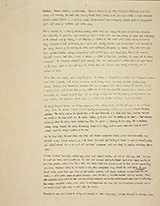 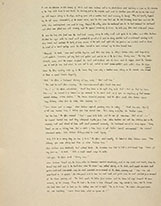 Faulkner himself decided that the last of the three possibilities above should be first when he prepared the typescript. On its very clean first page (below left), he takes the story about Colonel John in 1863 that begins on page 3 of the manuscript and recasts it as a first-person tale being told long afterward by Will Falls; this is also the way Day's edition of the novel begins. At some point, Faulkner seems to have considered beginning with the typescript page below center; the chapter number "4" is crossed out, and the handwritten "1" and especially the underlined Flags in the Dust at the top of the page all testify to that intention. (On all the manuscripts and typescripts that survive, Faulkner never writes out the title except on the first page.) And it even seems that Faulkner once considered beginning the novel with Horace Benbow rather than any of the Sartorises. What else could be signified by his decision to add a "I" (for Part I) and "1" (for Chapter 1) at the top of page "83" of the manuscript (below right) , crossing out the "7" he had earlier written there? (In the published texts, Horace's return to Jefferson is of course the way Part III begins.)
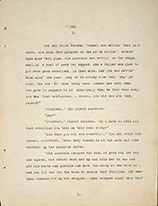 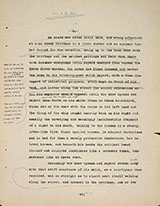  The three manuscript pages below — numbered, from left to right, 02, 04 and 05 — will give you an idea of how Faulkner imagined developing the narrative of the twins, Bayard and Evelyn. (Among the four pages not shown are two numbered "002" and "003," which were interpolated between pages 02 and 03; in them "Evelyn" is called John, the name Faulkner used everywhere else.) After beginning in the middle of the Great War, this narrative goes back only as far as the twins' rowdy youth.
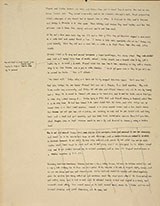 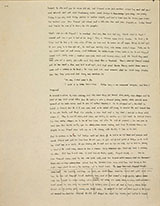 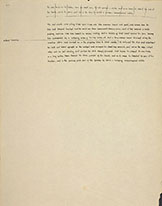 And the following three pages — 2, 6 and 7 — indicate how Faulkner develops the Sartoris story instead by moving backward from 1918, when old Bayard opens the chest of heirlooms in the attic and stirs up the ghosts of Sartorises as far back as the Battle of Agincourt. Like the aerial combat Bayard and his brother engage in, this ancestral Sartoris is fighting with English forces in France, but in its outline of the family's history from fifteenth century Europe across the Atlantic and through colonial Virginia to "northern Mississippi" in the decades before the Civil War, this narrative locates the family in a much longer, more mythic historical context. At the same time, it confronts the actual Southern past more directly. It contains the earliest of the version of an event Faulkner would write and re-write several times over the course of his career: Colonel Sartoris' killing of the two Yankees who were trying to give the newly-emancipated African Americans a chance to vote. (On page 6 you can read one of Faulkner's first descriptions of the place he here calls "Yocona" county.)
 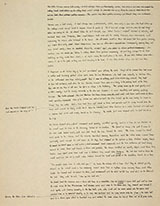  There is scholarly disagreement on the relationship between the manuscript and the extant typescript, though the consensus seems to be that Faulkner worked on both at more or less the same time, writing a certain amount in longhand and then pausing to type that material up, revising as he did so, then going back to resume work on the manuscript, and so on. Both documents show clearly how, even after he'd found his starting point, Faulkner continued to revise frequently throughout the composition process. Nearly all the pages above show the signs of such revising, which is equally obvious when you contrast manuscript and typescript versions of the same passage. And the rewriting went on continuously during and after the typing, as you can see from the pages below. Left: old Bayard returns home from his day at the bank; note the page numbers at the bottom, indicating that Faulkner shifted this event 26 pages later before moving it 43 pages earlier. Center: this page from the description of Horace's homecoming was shifted around six times after it was first typed, ending up over 100 pages away from its original place. Right: one of the pages that record how often Faulkner re-imagined the novel's larger structure; together those numbers at the bottom and top of the page indicate that at one time or another this passage was moved forward and backward over 100 pages and was considered as the start of four different Chapters in two different Parts.
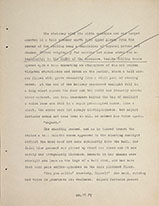 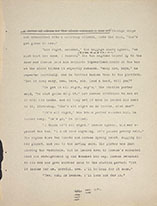 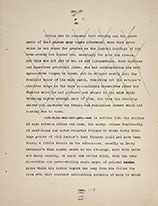 This typescript also contains a great many handwritten changes in the text, another sign of ongoing creative ferment out of which Yoknapatawpha came. Below left: the handwritten passage Faulkner added to page 280 tightens up the description of Horace leaving home to pay Belle a visit, but the cancelled passage is worth reading for its attempt to represent Horace's thoughts using the stream-of-consciousness technique that James Joyce had made famous. If Faulkner had left this in, "Antic before thy female, O ape" (which sounds more like T.S. Eliot than like Joyce) would have been the first instance of this technique in the Faulkner canon. Below right: Faulkner seems to have decided after typing over the manuscript to restore the description of Evelyn/John's death in the skies over France, written for one of the original beginnings (above, top), though he shifts the perspective from the third-person to Bayard's, as he recounts the event to a horrified Narcissa
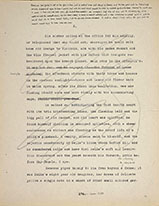  If you want to learn more about what scholars have had to say about the composition, revisions and publications of Sartoris|Flags in the Dust, four good places to start are: Stephen Neal Dennis, "The Making of Sartoris: A Description and Discussion of the Manuscript and Composite Typescript of William Faulkner's Third Novel," Diss. Cornell University, 1969; George F. Hayhoe, "A Critical and Textual Study of William Faulkner's Flags in the Dust," Diss. University of South Carolina, 1979; James E. Kibler, Jr., "Review" of Dennis' dissertation, Mississippi Quarterly 24 (Summer 1971): 315-19; Hayhoe, "Review" of Day's 1973 edition, Mississippi Quarterly 28 (Summer 1975): 370-86. Hayhoe published a transcription of the entire World War I beginning (pages 01-05) in "The Rejected Manuscript Opening of Flags in the Dust," Mississippi Quarterly 33 (Summer 1980): 371-83. Citing this source: |
